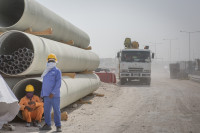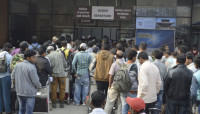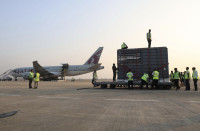Opinion
Rising India
India today is admired by Africans, courted by the West, loved by Southeast Asians but feared by its neighbours
The Raisina Dialogue is envisioned as India’s flagship conference of geopolitics and geo-economics and designed to explore prospects and opportunities for Asian integration as well as India’s vital role in Asia. In the South Asian region, we have been discussing Asia’s physical, economic, digital connectivity from quite some time now. This dialogue encompassing both track-I (official) and track-II (informal) diplomacy, is an important platform to initiate a frank conversation between India and the world. As India emerges as a powerful player in international affairs, platforms such as these are useful links to build ties with the neighbours and the wider international community.
Experts have always stressed the need to improve regional connectivity to support economic development that transcends our borders. A hundred years ago, Rabindranath Tagore wrote the “Kabuliwalah” in which an Afghani merchant comes all the way to Calcutta to sell his dry fruits—over the decades this has become virtually impossible.
New walls
Our borders used to be bazaars where people would meet, trade goods and exchange ideas, but today they have become barriers to trade. They are, in fact, places of opportunity for the miscreants. Even before the European Union was created, India and Nepal agreed on an open border, a visa-less system where citizens of one country could easily travel and live in the other.
Over the years, this unique relationship is also undergoing change and there are pressures from both sides to regulate the open border. We have become more connected with the outside world than among ourselves. Migrant workers from India, Pakistan, Nepal and Bangladesh are currently working day and night, hand in hand to construct stadiums in Qatar but we cannot work hand in hand in our own region.
At the moment, among the top six troop contributors to the United Nations Peacekeeping operations worldwide, three are South Asian countries, but we cannot build peace in our region. Among the listed one hundred top ranking universities in the world, not a single one is in South Asia. But if we see the top 10 universities, most of them have Departments or Institutes of South Asian Studies, usually teaching South Asian languages run by South Asian faculty.
Professionals from our region such as doctors, scientists, engineers, professors are neglected in their own countries but excel in the West. India has become a leading space power yet the security light that glows orange at night at the fortified Indo-Pak border is visible from the outer space. India is today admired by Africans, courted by the West, loved by Southeast Asians but feared by its own smaller neighbours.
India and China have risen and fallen several times in their history and each time we in Nepal have benefited from the progress and prosperity up north or down south and also suffered from their internal strife or economic decline.
Geopolitical realities
With 7.5 percent annual GDP growth, India’s success story is an opportunity for us in the neighbourhood. Its expanding middle class, burgeoning trade with the rest of the world, influence in global political, security and economic discussions presents Nepal once again with a historic opening to piggy-back and reap benefits for our own poverty alleviation efforts.
But a moot question is where is India rising?
It is certainly rising in Hyderabad, Bangalore, Delhi, Gurgaon, Mumbai but none of them are anywhere near Nepal. According to one report, the wealthiest cities in India are: Panaji (Goa), Chandigarh, Delhi, Valparai (Tamil Nadu), Pune and Chennai. Those are also nowhere near the borders of any of the neighbouring countries. In fact, the opposite is true.
The C. Rangarajan panel declared that in the seven poorest states of India, over forty percent of the people are below the poverty line. And among them are Bihar, Manipur and Assam that border Nepal, Myanmar, Bangladesh and Bhutan.
More specifically, Nepal borders the districts of Baharaich, Sarbasti, Balrampur, East Champaran, Sitamarhi, Madhubani, Kishangunj and Maharajgunj that by all indices are the most backward areas of today’s India. If one sees the indices in sectors such as health, education, transportation, sanitation, these areas are on the rock bottom in the whole of the country. It is because, India has neglected infrastructure, connectivity, roads and railways, education and health services in the bordering areas with all the neighbouring countries. It is swelling in the middle with little regard to its periphery. This has led to mass migration to the urban areas necessitating grand concepts such as ‘smart cities’ but even those that are planned are not in the bordering areas.
Another factor at play is that while the BJP rules the centre, all the bordering states with Nepal are ruled by opposition parties—Uttarakhand, Uttar Pradesh (UP), Bihar, Sikkim and West Bengal. This is where the challenge lies. We are told that in a mature democracy, it does not matter if there are differing parties ruling the centre and the states but seeing the plight of a poor North Bihari or a person of a backward caste from Eastern UP gives us a different picture.
So, when we talk about economic cooperation with our southern neighbour, the sub regional aspect of North India must first be understood. We are hopeful that there will be trickle down effects.
Connectivity and development
Then they are the trans-shipment procedures, documentation requirements, hassles by border guards, and poor infrastructure. Transit by road takes 2.7 times longer in the Indo-Nepal border than ideally under efficient conditions. Except for Afghanistan-Pakistan, none of the other Saarc countries are connected among themselves except via Indian territory. It is therefore imperative that Delhi gives adequate priority to the physical infrastructure at its side of the border with all neighbouring countries.
Two weeks ago, the world woke up to the news of the first train to connect China and Iran carrying 32 containers that took 14 days to make the 9 thousand km journey through Kazakhstan and Turkmenistan. The Golmud-Lhasa railway currently operational till Shigatse will pass through highest rail tunnels in the world to reach the Nepal border at Syafrubesi in a few years time.
Instead of waking up to hear the news one fine morning, we in the sub-region must make collective efforts to reap benefits from the vast Chinese market that opens up as a result of this rail-line. Of course, the Chinese will also make profit as it will bring Nepal and the land-locked Indian states of UP and Bihar closer to its products like never before.
This is why connectivity and infrastructure development must be seen in its totality as it reconnects the damaged trade ties and helps build us once again as a prosperous region. Merchants from Kabul can come again, this time not in a short story or a movie but in real life to Kolkata, Patna, Kathmandu and even beyond.
Pandey was a speaker at the “Raisina Dialogue” (March 2-3) organised by the Observer Research Foundation and Ministry of External Affairs of India in New Delhi. He is the Director at the Centre for South Asian Studies in Kathmandu




 7.12°C Kathmandu
7.12°C Kathmandu








%20(1).jpg&w=300&height=200)

